Anchor
Line; RMS Circassia (3), Cilicia,
Please Note: Firefox & Google Chrome may not be suitable
Use Internet Explorer or Old Google for this page
to load perfectly!
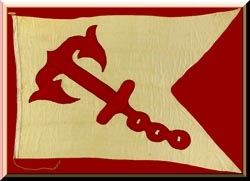

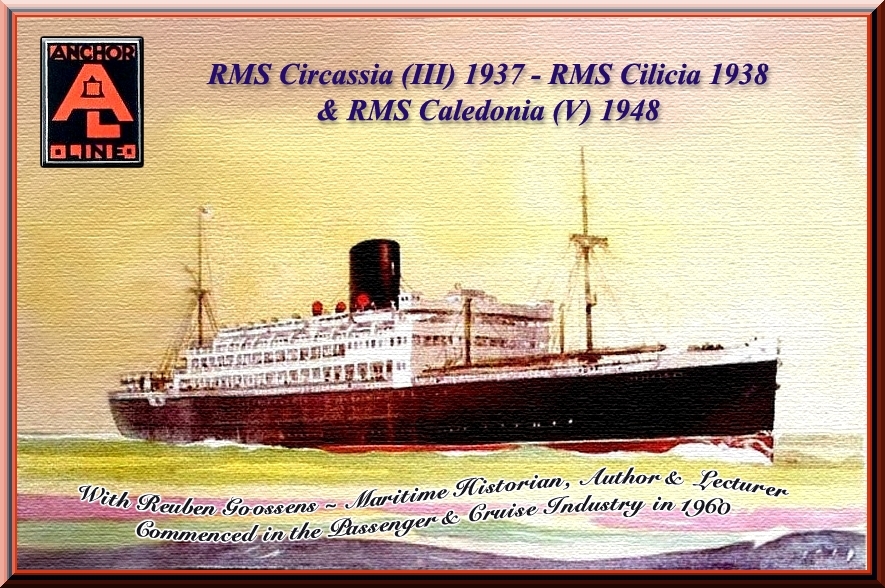
Introduction:
Anchor Line was founded in 1856 as Handysides & Henderson although Handysides & Co. had owned ships prior to this date. In 1872 the Barrow Steamship Co. was formed in partnership with the Duke of Devonshire and ships were later transferred between Anchor Line and Barrow SS Co., but the two companies have been treated as one for the purposes of this list.
Anchor Line
ordered their very first ship being the iron hulled sailing ship, the Tempest,
which was built by Sandeman & McLaurin
of Whiteinch in
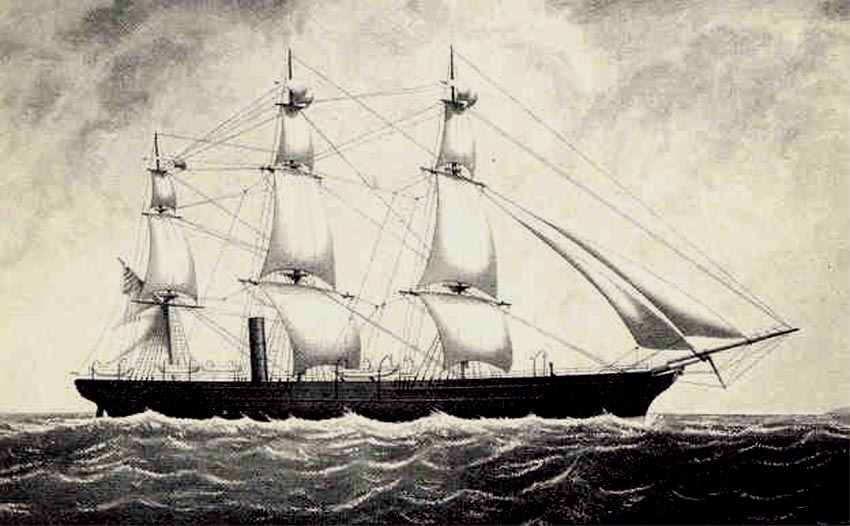
The Steam and sailing ship, Tempest,
In 1911 Cunard purchased all of the share capital
of Anchor Line and in 1912 a joint service was formed to
The firm of Anchor Line went into liquidation in 1935, however additional finance was injected by Runciman Ltd and a new concern, Anchor Line Ltd in 1935 was formed. Anchor-Donaldson and Anchor-Brocklebank ceased to exist and Cunard had no further connection with the new company. At the outbreak of World War II, Anchor Line Ltd owned nine ships and one on the stocks. Tragically six of these ten ships were lost.
In 1949 United Molasses Co (Athel Line) gained a controlling interest in the company and by 1950 they owned the whole ordinary share capital.
The Trans-Atlantic passenger services
concluded in 1956, but in 1960 a new joint Anchor-Cunard service was
introduced. United Molasses Co. became a subsidiary of Tate & Lyle in 1965,
and Anchor Line was sold to Runciman & Co.,
Sadly the RMS Circassia operated the very last
passenger voyage to
Please Note:
I will describe these ships as follows; 1.
Pre-war: Descriptions & statistics for the first two ships, the RMS
Circassia and
**************************
Ship 1 - RMS Circassia (3):
RMS Circassia was the first of the three
Anchor Lines motor ships to be constructed at the Fairfield Shipbuilding &
Engineering Co. Ltd, at
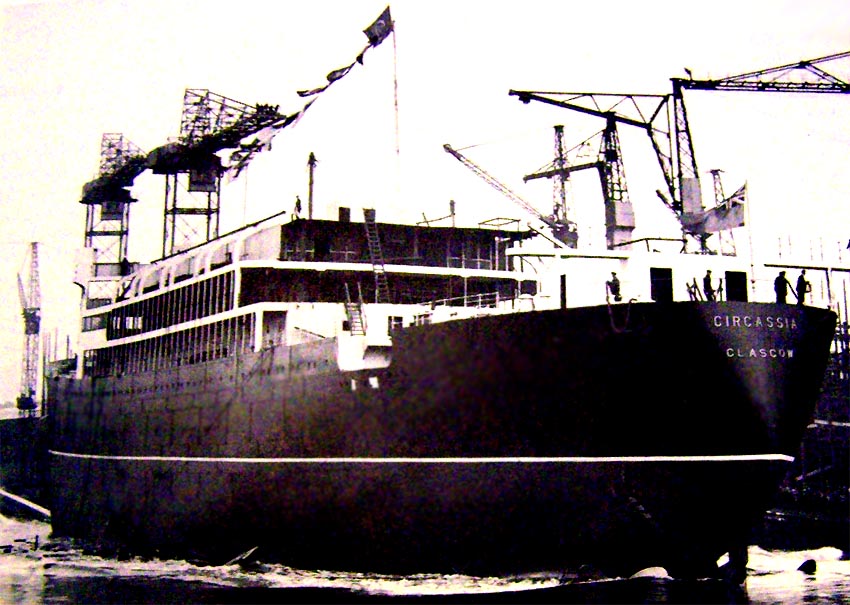
The
Photo originally provided by the Fairfield Shipyards, Glasgow
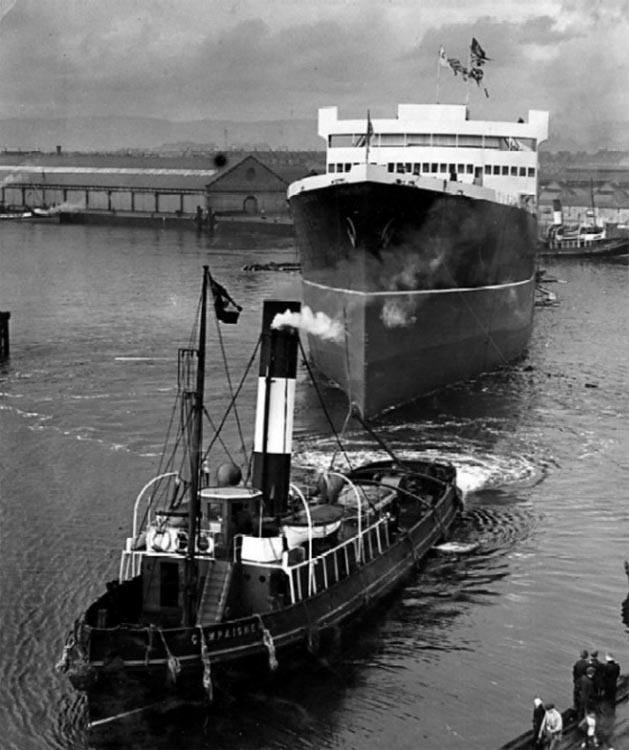
Here see the
partially completed liner under-tow to her
Photo originally provided by the
Fairfield Shipyards, Glasgow
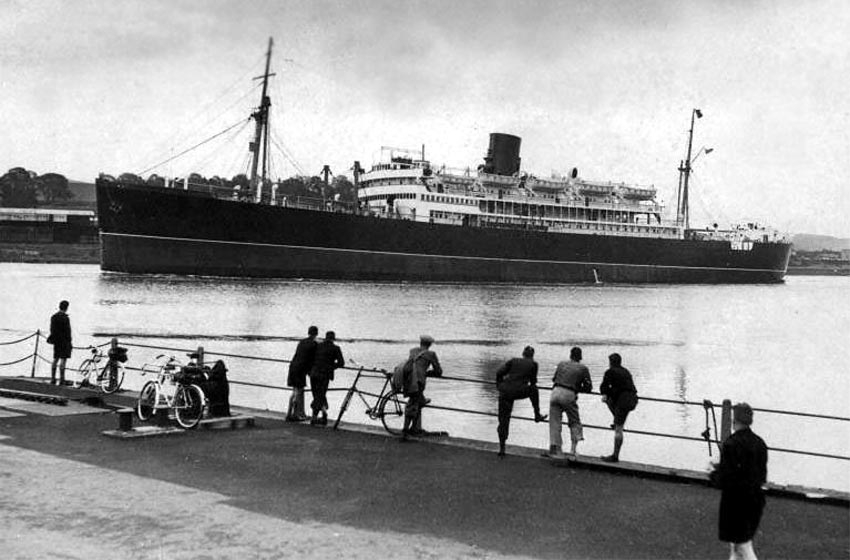
The RMS Circassia is seen returning from her sea trials in October 1937
Photo originally provided by the Fairfield Shipyards, Glasgow
RMS Circassia was delivered to her owners in
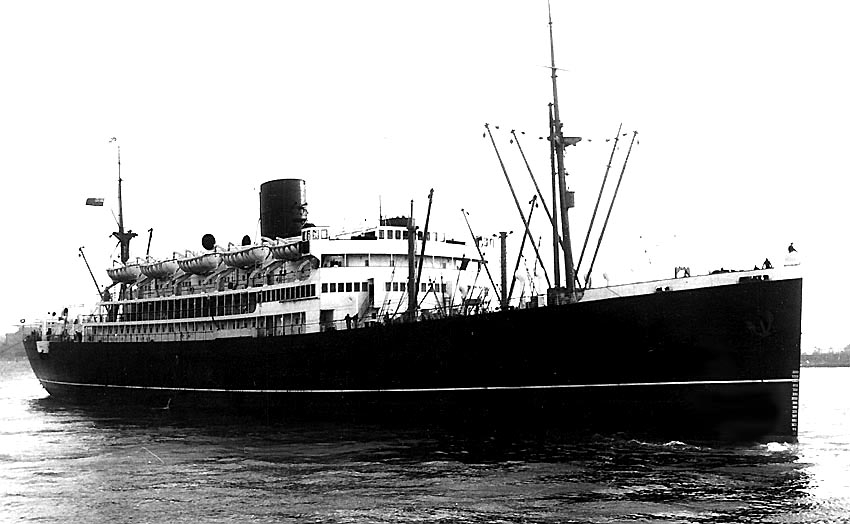
A fine looking Liner the RMS Circassia
Passenger Decks were arranged and named as follows:
Sports/Sun Deck offered extensive space for spots or sun baking as well as the Swimming Pool aft of the funnel.
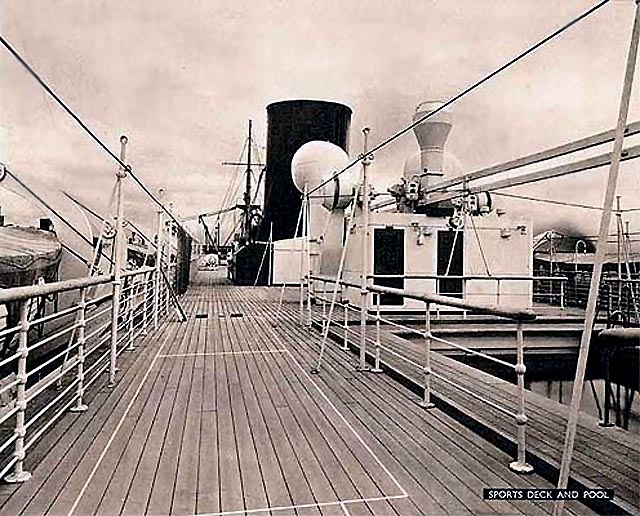
Sports/Sun Deck; here we see the Swimming Pool
Please Note: All interior
& deck photographs of all 3 ships were sourced from a 1960s brochure seen
down the page
All other photographs are from the author’s private collection, unless mentioned otherwise
Boat Deck offered mostly cabins with all 2-berth cabins, and three of the 3-berth cabins had private facilities, whilst all cabins had windows. Aft was the Children’s Playroom, as well a children’s play deck.
Promenade Deck contained all the ships Lounges, the Main Lounge, the Lobby, the Long Gallery, Reading and Writing Room, as well as a library. Aft was the very popular Verandah Café offering views over the aft of the ship.
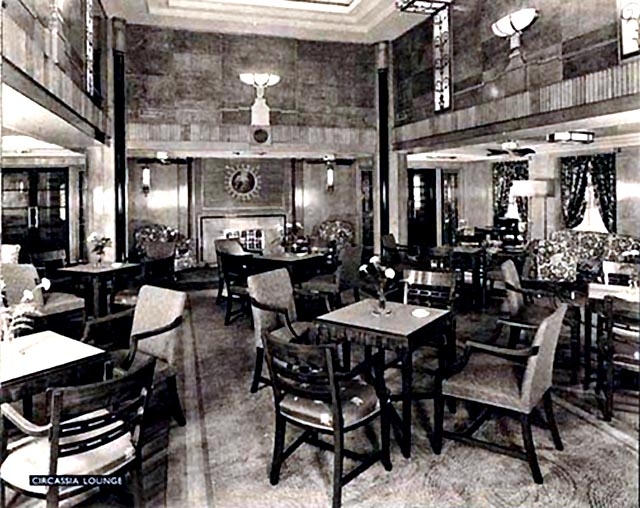
This superbly
beautiful Main Lounge
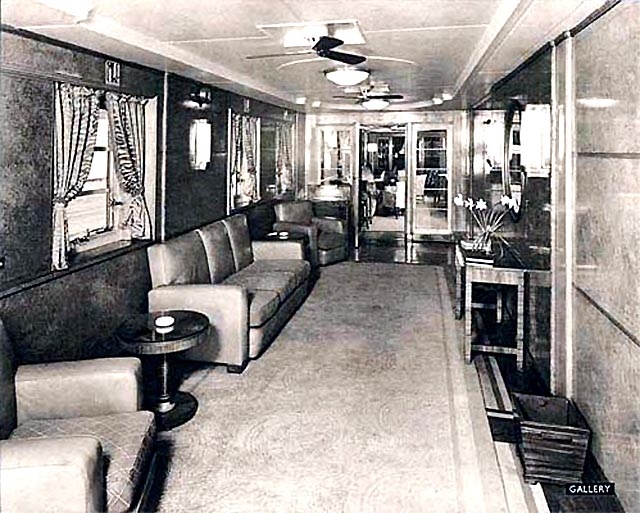
The Gallery
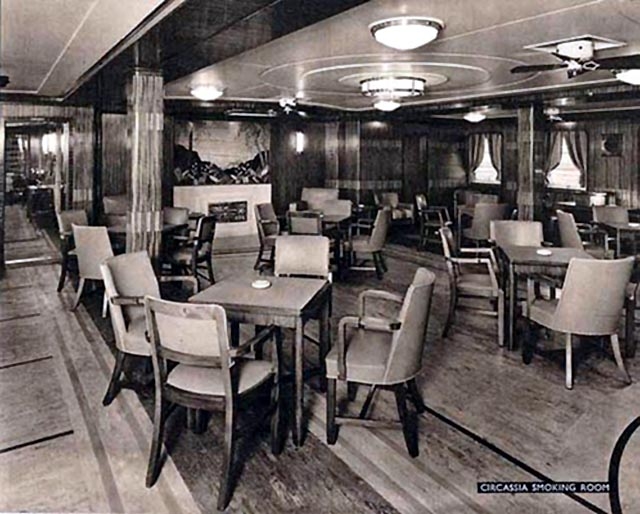
The Smoking Room
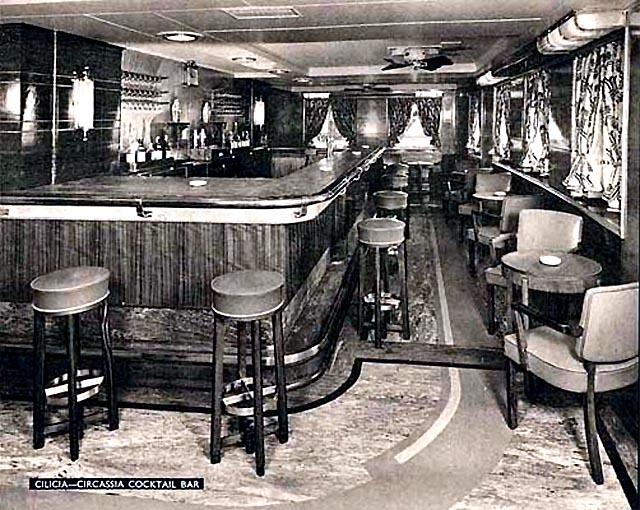
The popular
Cocktail Bar
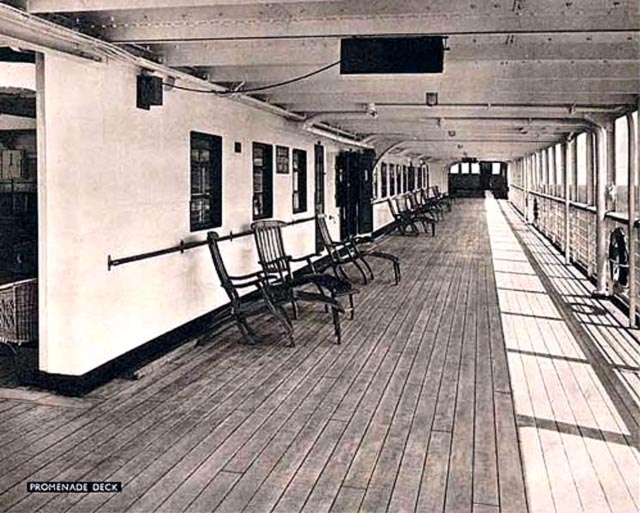
Heading outside
there was a spacious Promenade deck
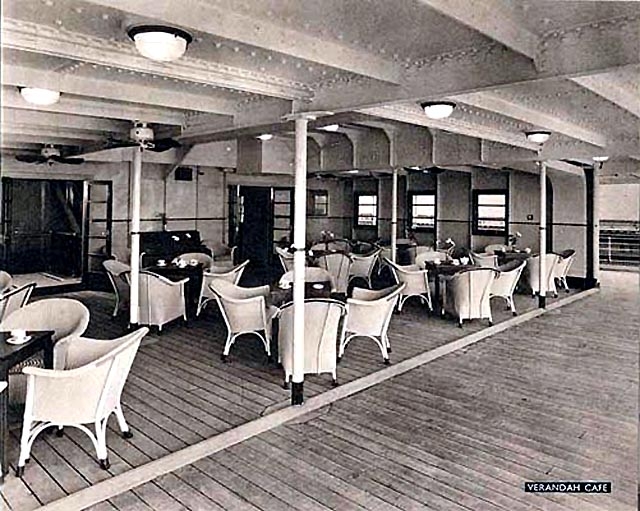
Far aft was the very popular Verandah Café
A (or Weather) Deck offered a number of deluxe beautifully timber panelled staterooms, which had private facilities. All staterooms and cabins had a window. The forward Lobby and Grand Stairwell was the ships Main Entrance and Lobby, being the location for the Pursers Office, the Hairdresser and a Shop.
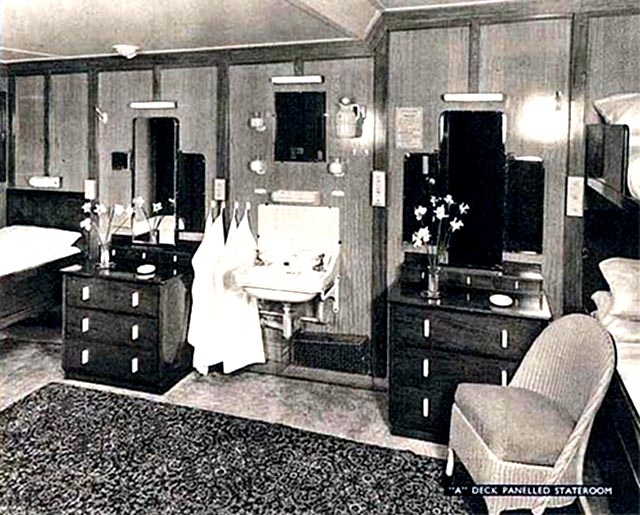
Here we see one of the Deluxe panelled Staterooms on A deck
B Deck contained the medical centre as well as further accommodations, madder up of 2,3 and 4-berth cabins, all having a porthole aa well as a wash table with hot and cold water.
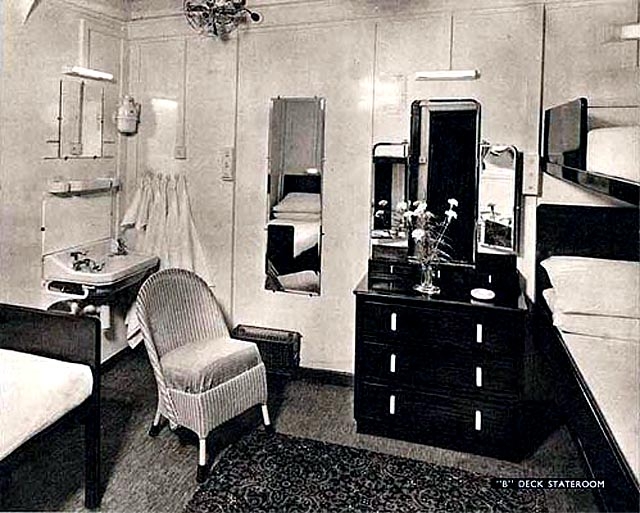
A typical three berth Stateroom on B Deck
C Deck was the
location of the ships Dining Room and galley.
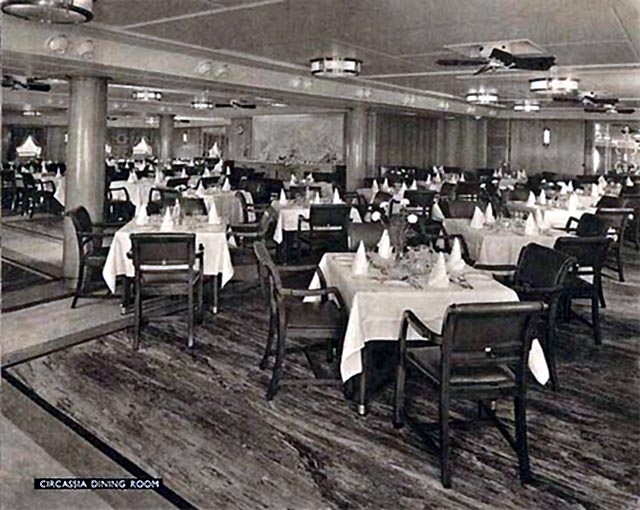
The Dining Room
It is important to Note - That all three ships had the same layout
RMS Circassia Specifications:
Built: Fairfield Shipbuilding & Engineering Co. Ltd., Govan.
Yard: 661.
Official number: 165916.
Launched: June
8, 1937.
Delivered: October 19, 1937.
Tonnage: 11.137
GRT, 10.287 dwt.
. 11,170 GRT in 1948.
Length: 483.6
ft - 141.25 m.
Breadth: 66.4
ft - 20.22 m.
Draft: 27.5
ft - 8.35 m.
Engines: Two
8-cylinder Fairfield-Doxford diesel engines - 14.000 BHP.
Propellers: Two
- 1.110 nhp.
Speed: 16.5
knots service speed, 18 knots maximum.
Passengers: First
Class 321 & Steerage 80.
Post War: First
Class 320 - 298 adults & 22 children.
Crew: 150.
Facilities: Partial
Air-Conditioning.
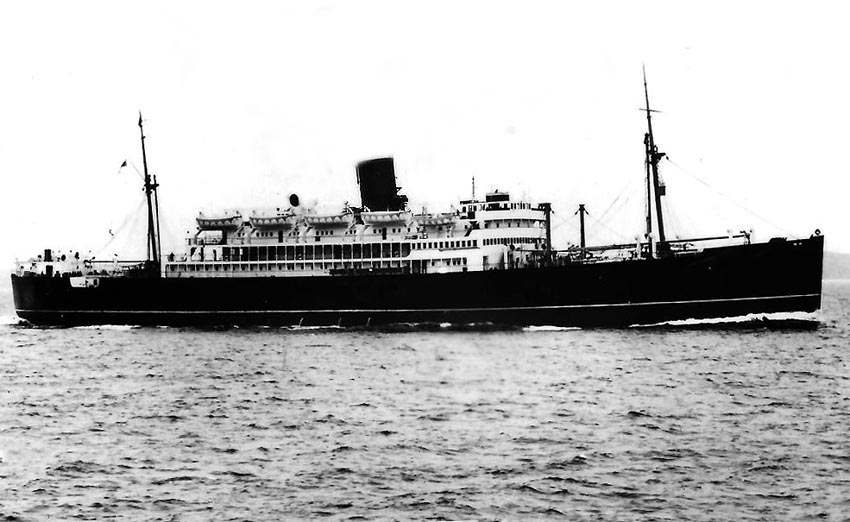
The RMS Circassia is seen pre-war in this photograph
RMS Circassia continued on her regular
Liverpool to
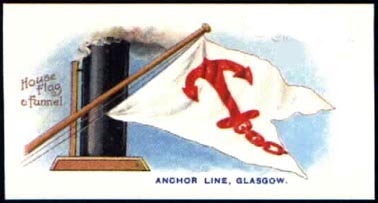
Ship 2 - RMS Cilicia:
The
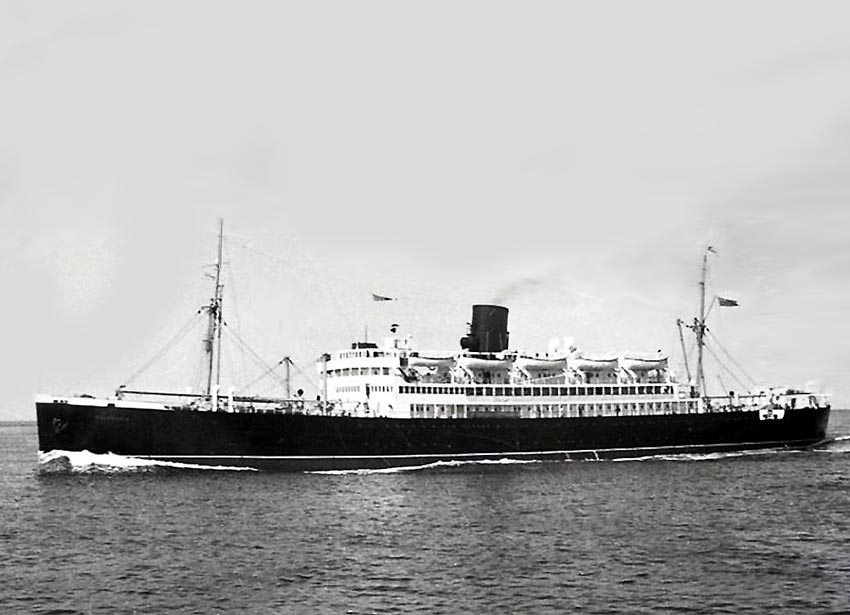
The RMS Cilicia is
seen sailing up the Mersey to
The ships layout was identical to the
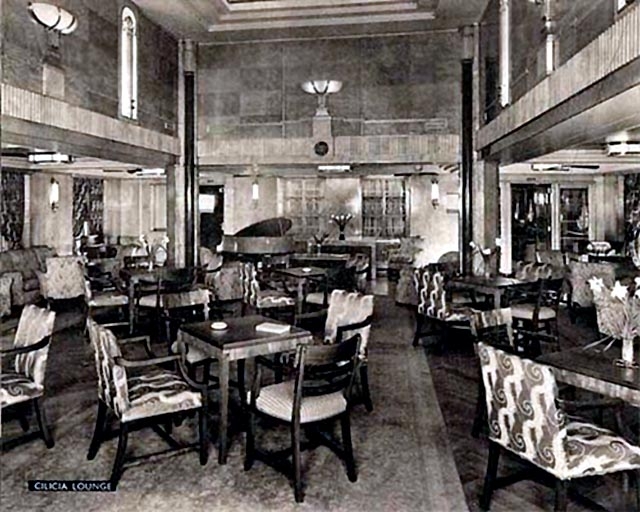
The Lounge looking forward to the Main Lobby & Stairwell
You will note
there were rounded windows in the upper level and other differences!
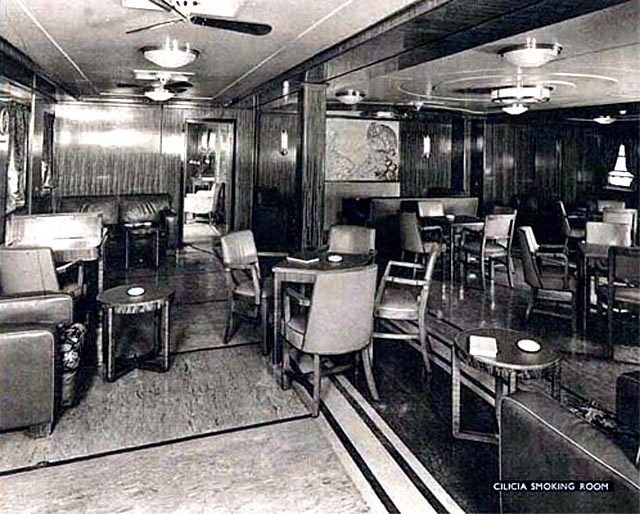
Smoking Room
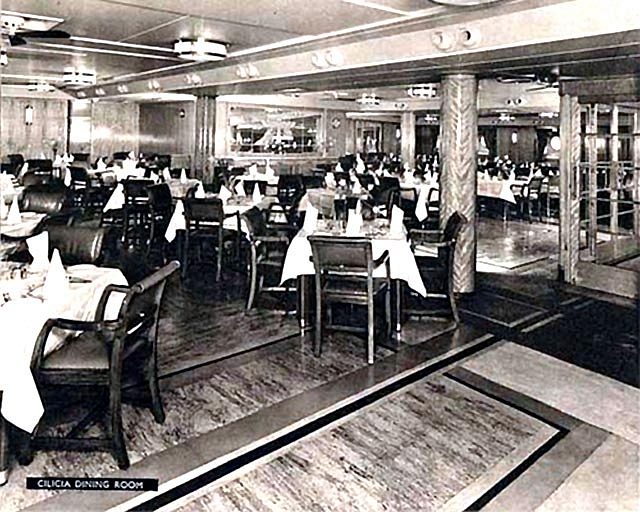
The Dining Room
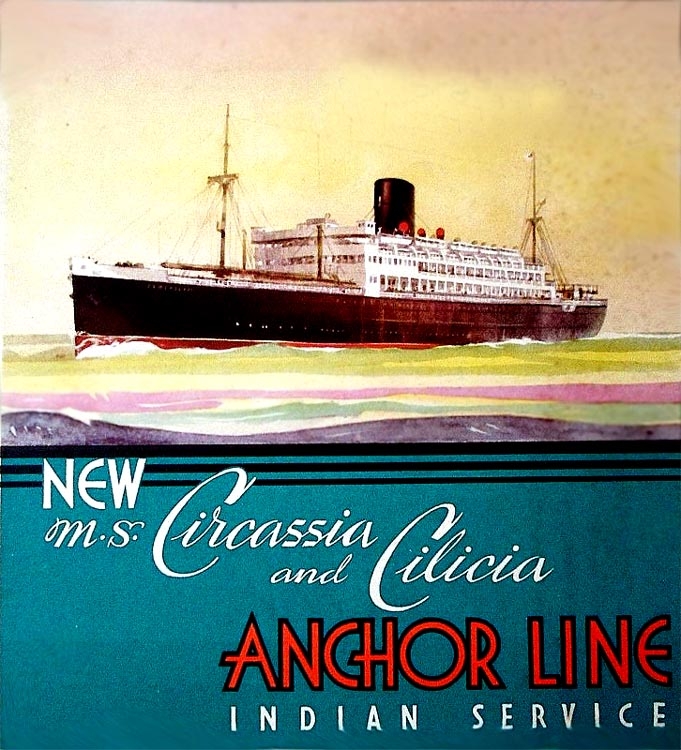
This Anchor Line
brochure was released in 1938 promoting their two new ships operating to
RMS Cilicia Specifications:
Built: Fairfield Shipbuilding & Engineering Co. Ltd., Govan.
Yard: 664.
Official number: 165934.
Launched: October 21, 1937.
Delivered: May 1938.
Tonnage: 11.136
GRT, 10.287 dwt.
. 11,172 GRT in 1947.
Length: 483.6
ft - 141.25 m.
Breadth: 66.4
ft - 20.22 m.
Draft: 27.5
ft - 8.35 m.
Engines: Two
8-cylinder Fairfield-Doxford diesel engines - 14.000 BHP.
Propellers: Two
- 1.110 nhp.
Speed: 16.5 knots service speed, 18 knots maximum.
Passengers: First
Class 321 & Steerage 80.
Post War: First
Class 320 - 298 adults & 22 children.
Crew: 150.
Facilities: Partial
Air-Conditioning.
Names: RMS Cilicia
1938 - HMS Cilicia 1939 - HMT
. RMS
Cilicia 1945 - Jan Backx 1966 - 1980 SS Cilicia.
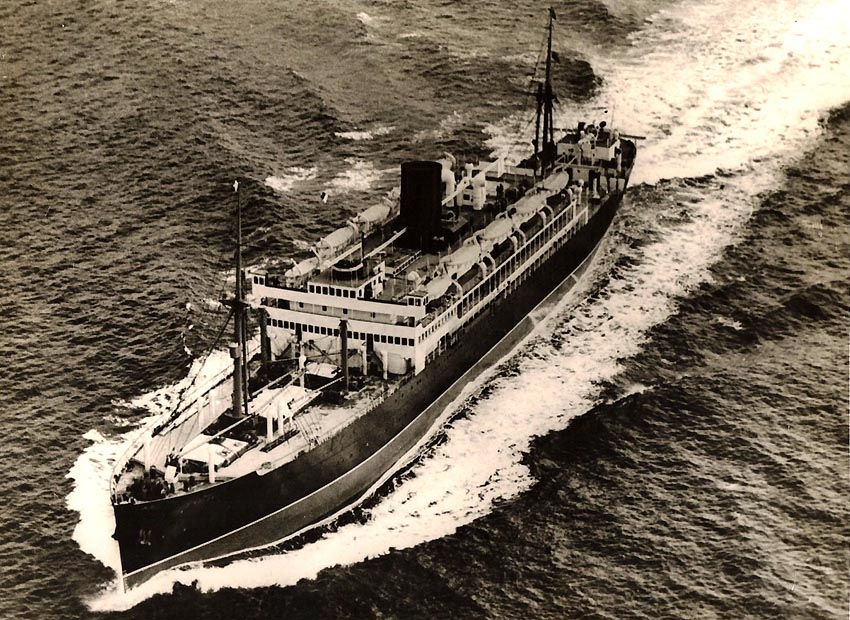
A fine aerial view
of the RMS Cilicia sailing at full speed ahead at sea
**************************
World War II:
HMT
RMS Circassia was commissioned in January 1940
and was converted to serve as an “Armed Merchant Cruiser” (AMC),
however in February 1942 she was refitted to become a troop ship with space for
over 2,000 troops, and she took part in the landings at
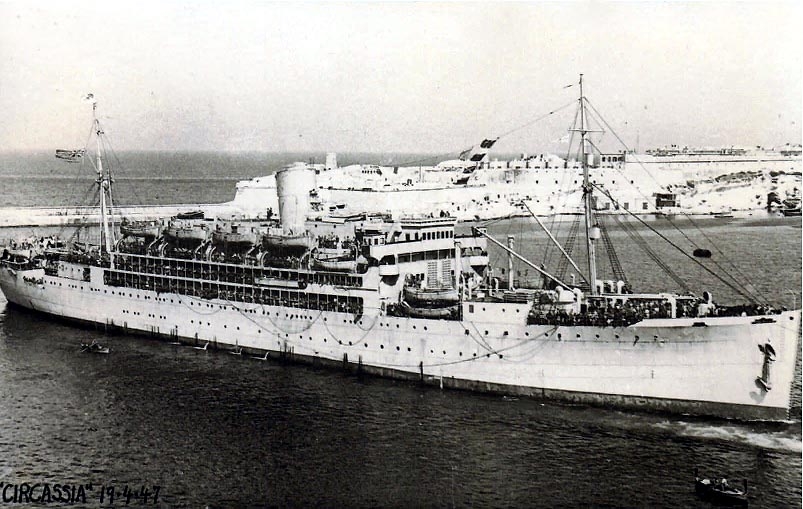
The
**************************
HMT
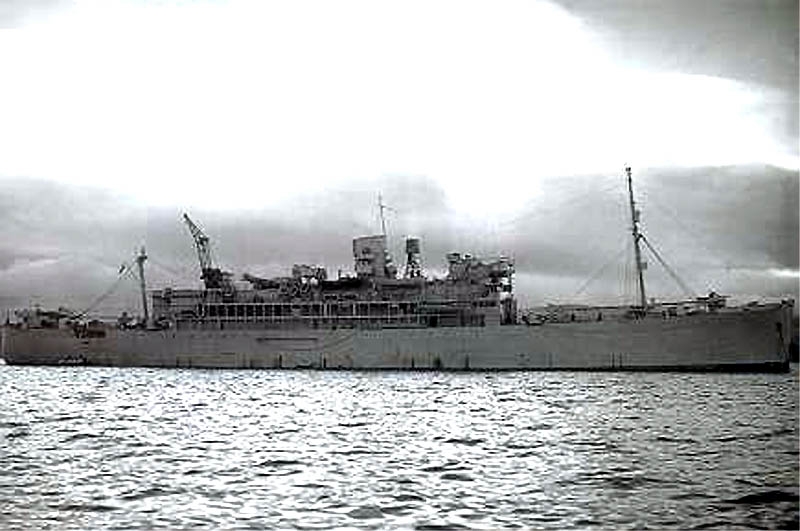
The
Upon completion she commenced her sailings now being able to transport 2,400 troops and continued in trooping duties until 1947.

Ship 3 - RMS Caledonia V:
The
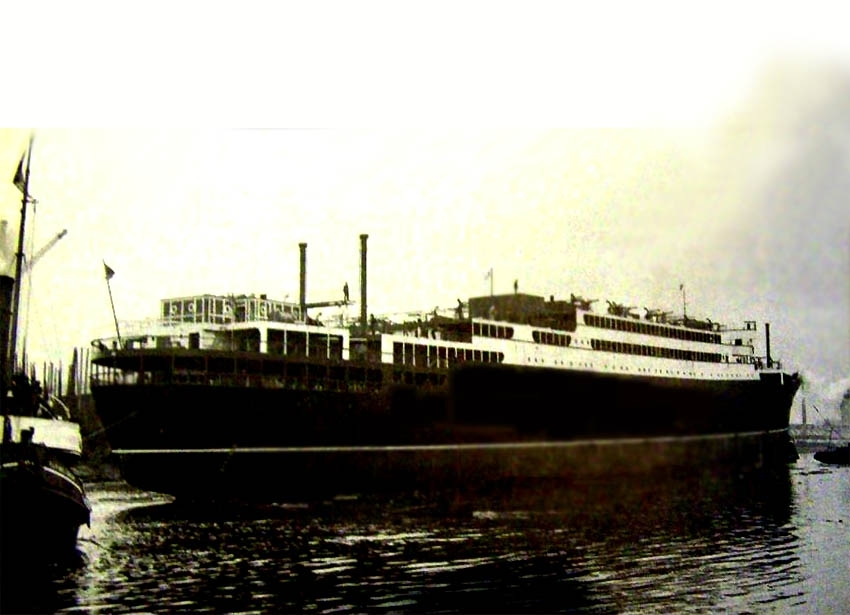
He we see the Caledonia V having just been launched and she is under tow to her fit-out berth
Photo originally provided by the
Fairfield Shipyards, Glasgow
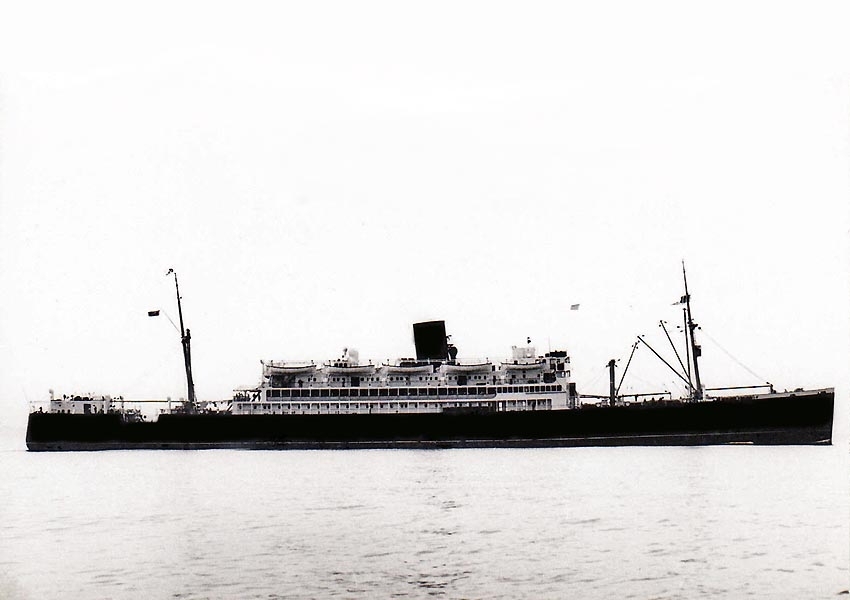
An excellent starboard study of RMS Caledonia at sea
Again, the
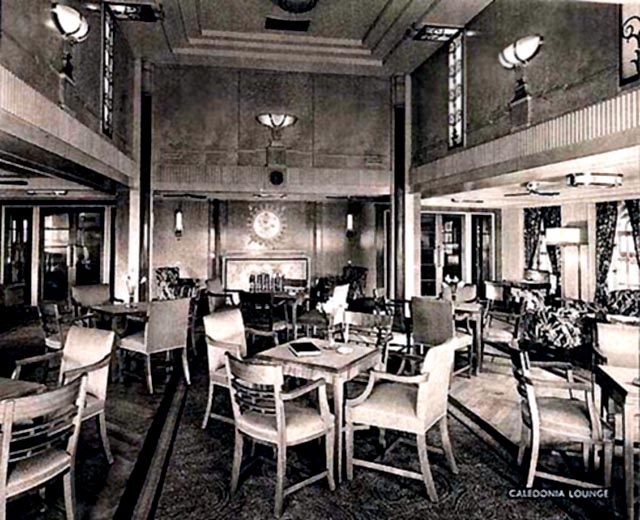
The Main Lounge
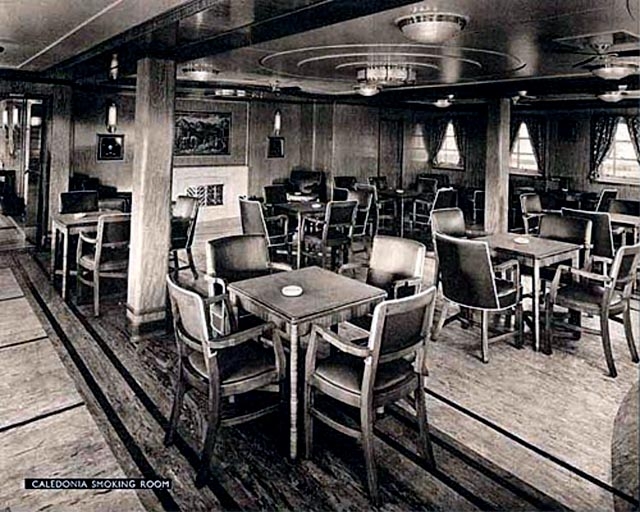
The Smoking Room
featured lighter timber panelling
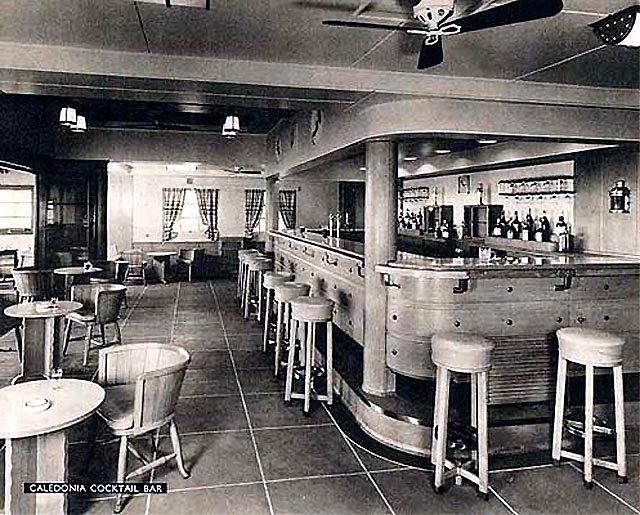
The Bar was given
a more modern look of the day
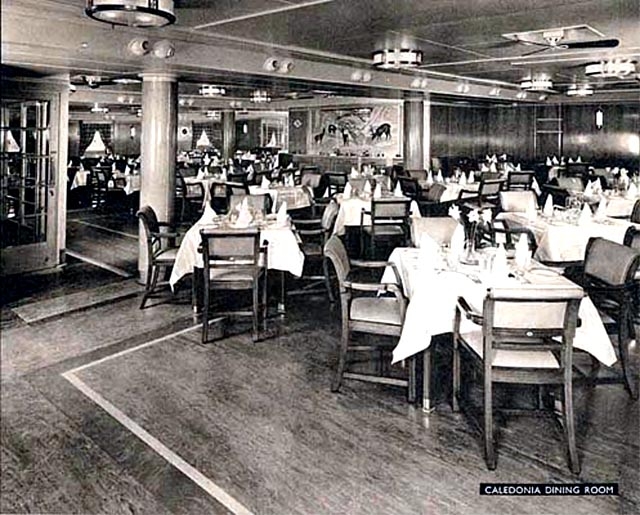
The Dining Room
was much the same as other ships, except the lighter beige leather upholstery on
the chairs.
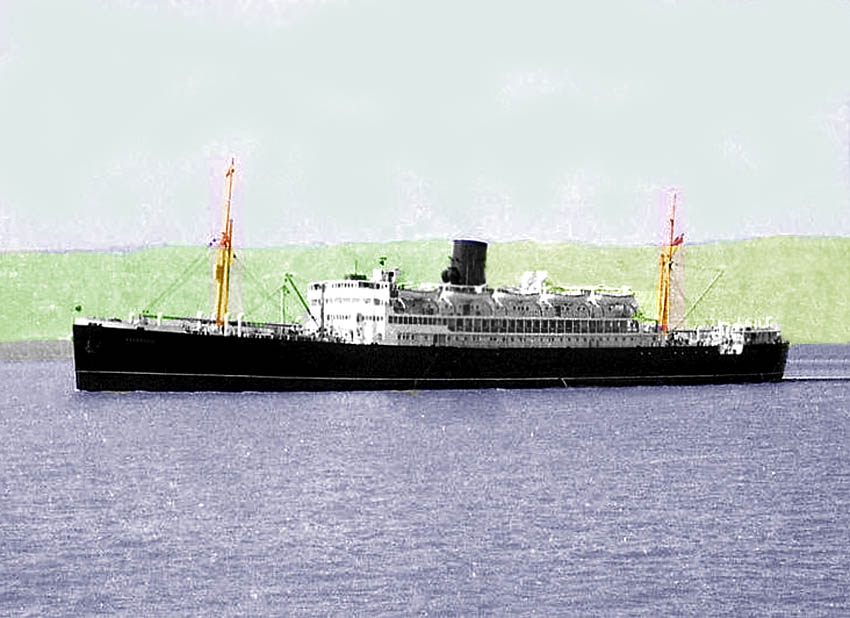
The RMS Caledonia
is seen in the
RMS Caledonia Specifications:
Built: Fairfield Shipbuilding & Engineering Co. Ltd., Govan.
Yard: 732.
Official number: 182083.
Launched: March 12, 1947.
Delivered: March 23, 1948.
Tonnage: 11.255
GRT, 10.417 dwt.
Length: 506
ft - 154.23 m.
Breadth: 66.5
ft - 20.24 m.
Draft: 27.4
ft - 8.33 m.
Engines: Two Fairfield-Doxford diesel engines - 14.000 BHP.
Propellers: Two
- 1.110 nhp.
Speed: 16.5 knots service speed, 18 knots maximum.
Passengers: First
Class 326 - 304 adults & & 22 children & Steerage 80.
Crew: 150.
Facilities: Partial
Air-Conditioning.
With the RMS Caledonia V being a post war ship meant that unlike her two sisters, she did not have to serve for the Navy or Army at any time, and thus remained a full time passenger liner, She continued to sail on her regular service from Liverpool to Bombay for a good seventeen years, until 1965, but I will cover her final days after her two earlier sisters war years.
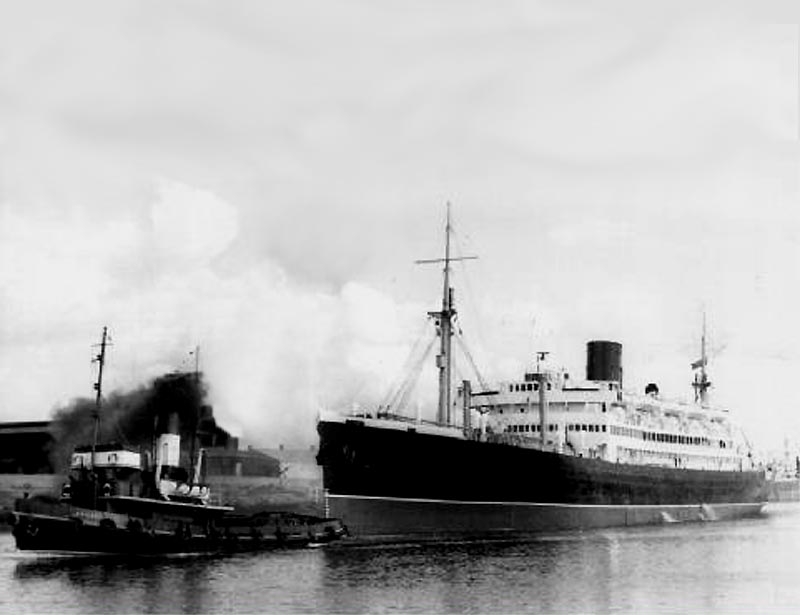
The Caledonia is
seen departing
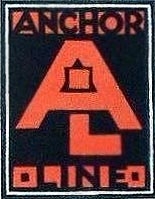
RMS Cilicia & Circassia
Return to Passenger Duties:
The RMS Cilicia was returned to Anchor
Line in 1947, a year before her earlier sister she was given a massive,
restoring her to her previous passenger liner glamour. Upon completion, she was
reregistered as being 11,172 GRT. She departed on her first post-war voyage
from
Both the RMS Circassia and Cilicia continued
on their regular return service from Liverpool, Gibraltar,
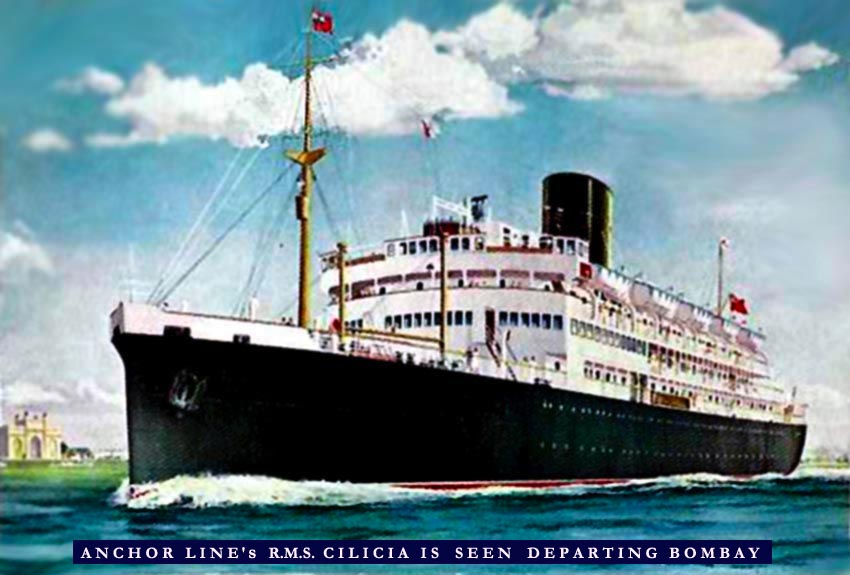
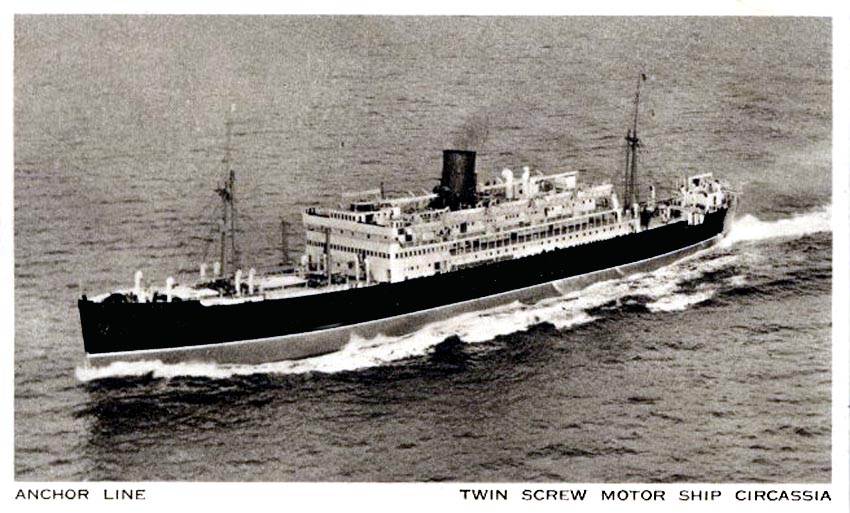
Above &
below: Two traditional postcards of the RMS
Circassia
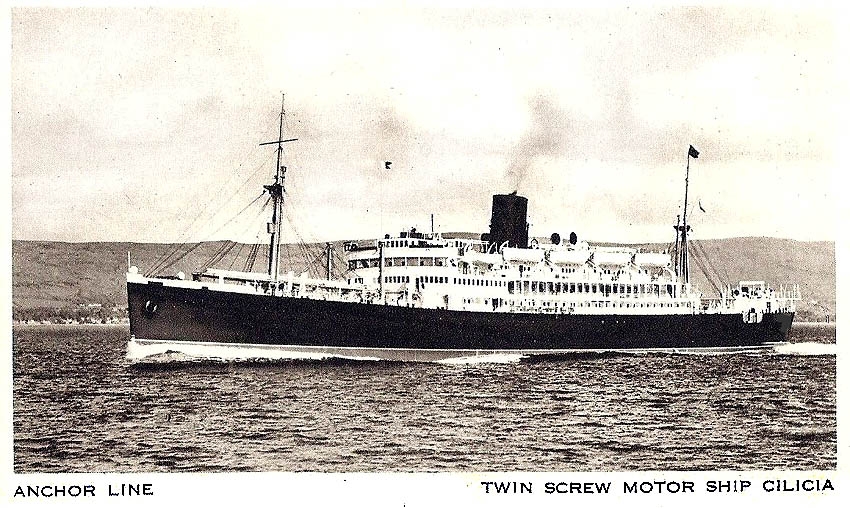
The Three Ships Final Days:
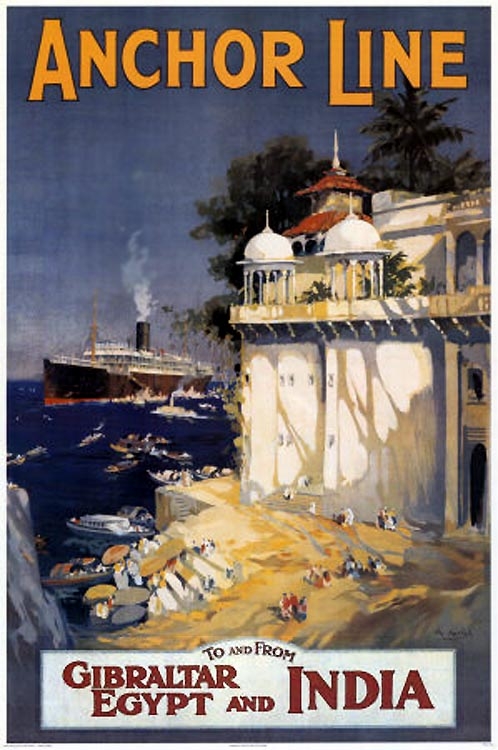
A 1960’s
brochure promoting all three ships and their services to
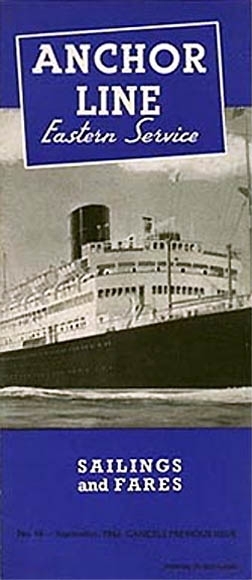
Here is another brochure with schedules & Fares from January 1962 until September 1964
1. RMS Circassia 3:
The Circassia continued on her regular voyages
to
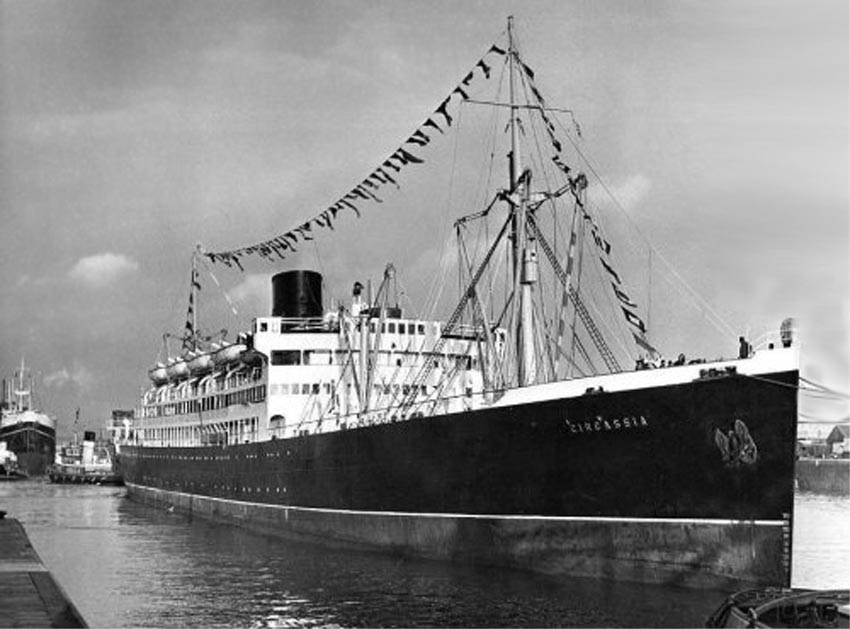
RMS Circassia is
seen departing for her final voyage to
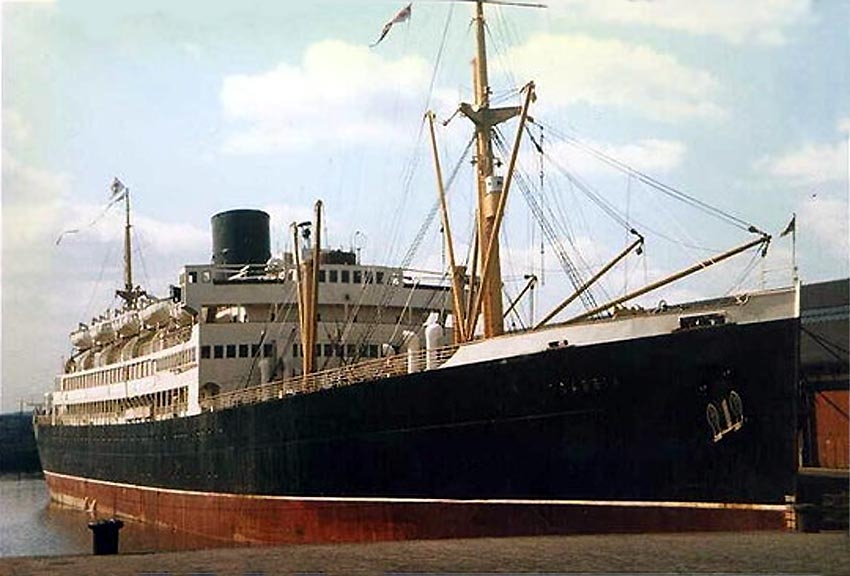
The Circassia is
seen on her final return voyage to the
Upon the return of the now twenty nine year
old liner, the Circassia was sold to Spanish ship breakers and it was soon she
headed for
However it should be known, for amazingly the
RMS Circassia (3) was the first of the three ships built, however, she, was in
fact the oldest of the trio ships that made Anchor Lines’ final passenger
voyage on Bombay, India service.
The
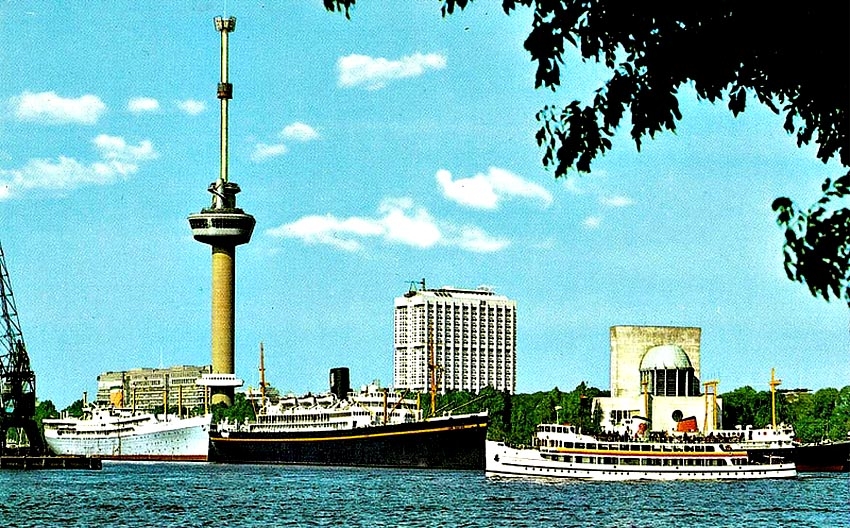
Ex
They are berthed
along the Parkhaven having the Euromast, and a huge
park alongside
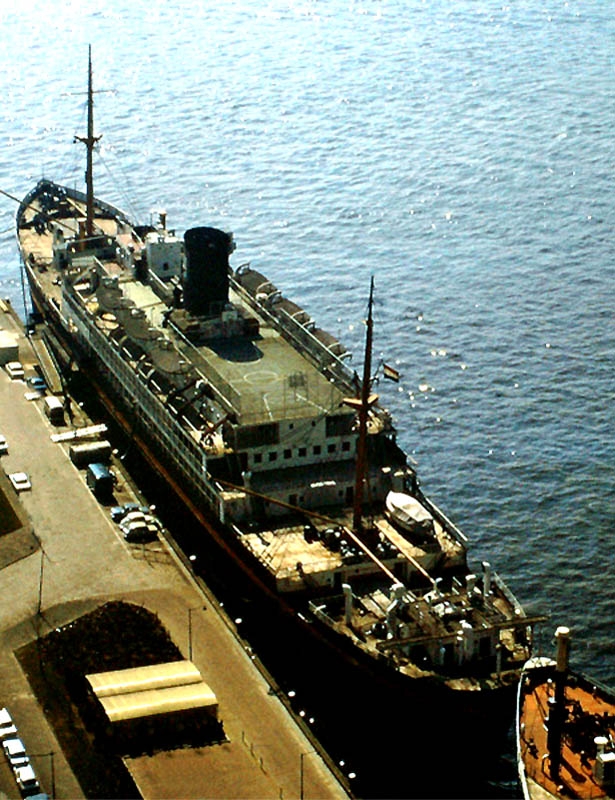
The Jan Backx is seen from high above as this photo was taken from the top of the Euromast in 1970
Photo sent in by a supporter, but photographer is unknown –
Please see the photo notes at the bottom of this page
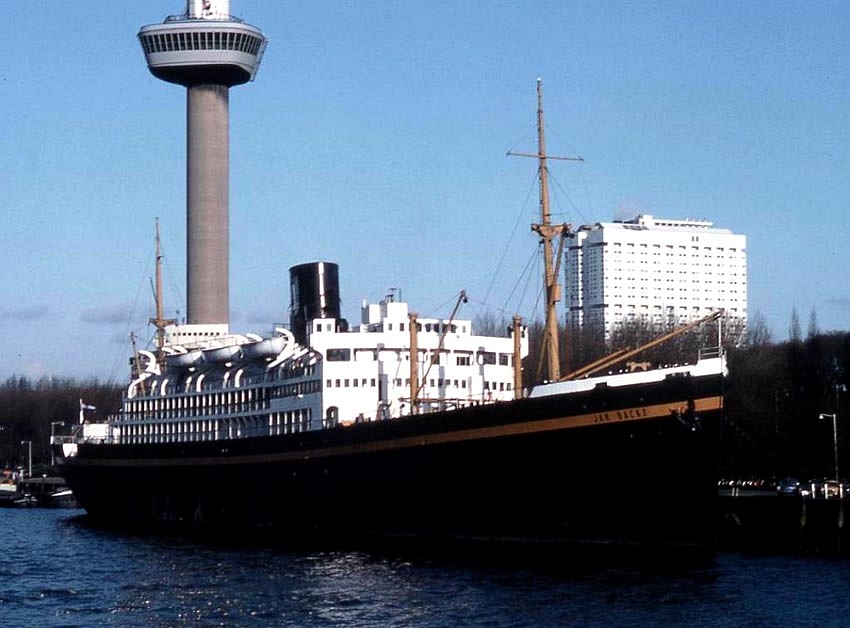
The Jan Backx is seen in 1979, the Seven Seas was moved to another location in the harbour
However, her days finally ended in 1980, as
she had been sold to a ship breaker at
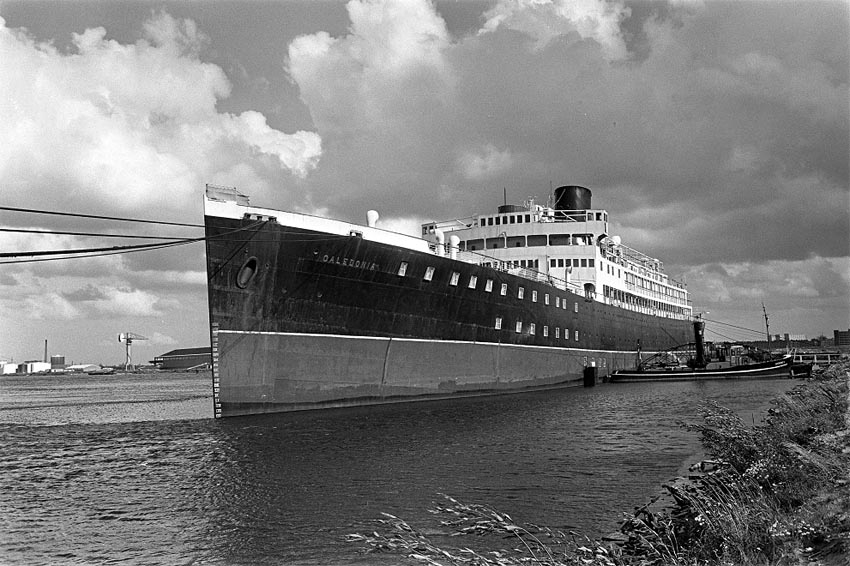
The floating
student hostel Caledonia, with new windows cut into her hull, is seen berthed
in
Photograph by & © Mr. Eric-Koch
Then in March 1970, she was sold by Moor Line
to the breakers, and was towed to
In Conclusion:
Although these three superbly built
11,000-tonne liners may have been built long before most of us were born, yet
they continued right through to 1966 for the RMS Circassia, which was also the
very last ship ever to operate a passenger service from Liverpool to

The first ship
built - RMS Circassia seen bound for
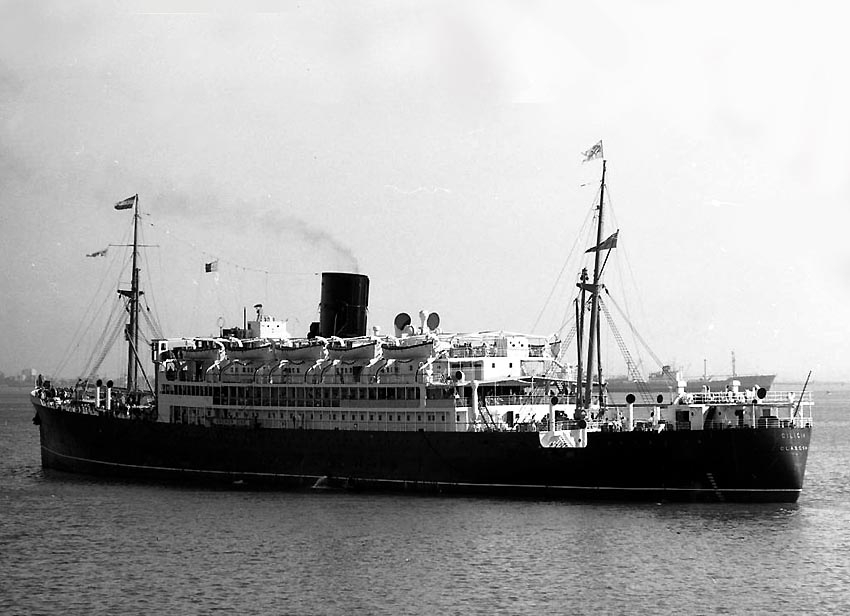
The second ship
built - RMS Cilicia RMS Cilicia is seen arriving at
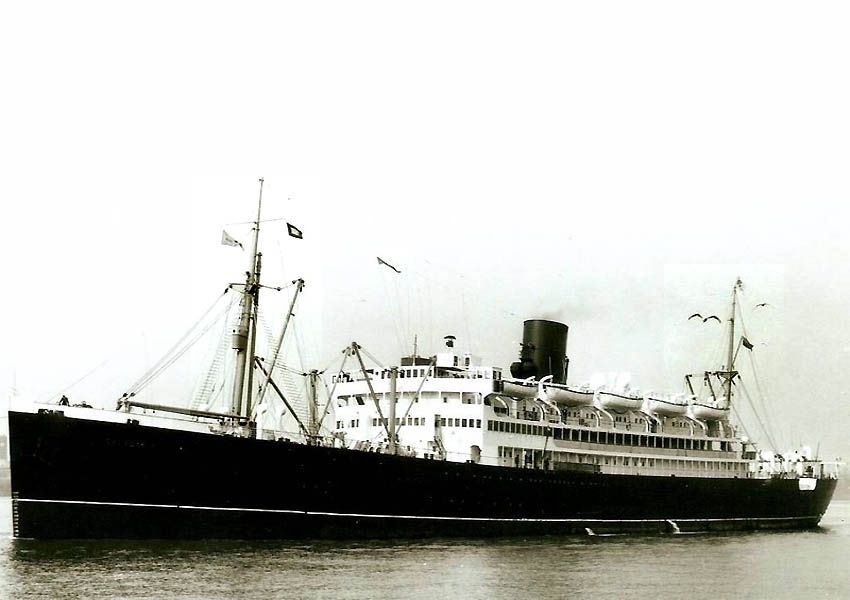
The third and 1948
built ship, the RMS Caledonia is seen departing
Photographer unknown – Please see the photo notes at the bottom
of this page
************************
I watched them come, I watched them go and I watched
them die.”
ENTER OUR ssMaritime MAIN INDEX
